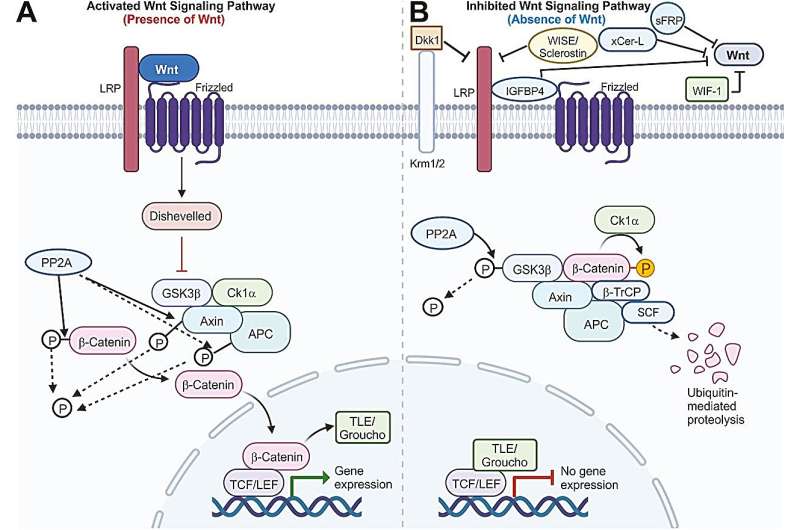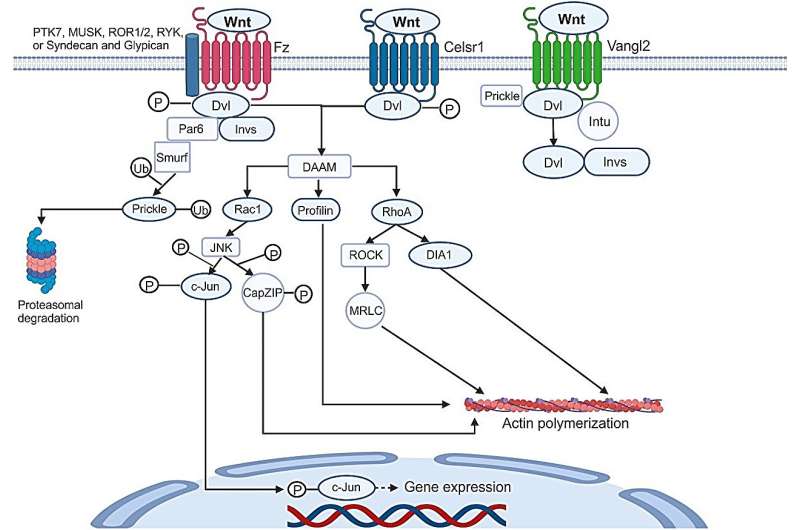This article has been reviewed according to Science X's editorial process and policies. Editors have highlighted the following attributes while ensuring the content's credibility:
fact-checked
proofread
The Wnt signaling pathway: The foundation of cell growth, development, and potential therapeutics

The Wnt signaling pathway, a system present in living organisms, plays a pivotal role in cell growth, differentiation, and migration. It has a long history dating back to 1982, when the first Wnt gene, essential for cellular growth, was discovered. The pathway is initiated by Wnt ligands, a set of 19 glycoproteins that transmit signals through specific receptors and proteins, leading to modifications in gene expression.
In a review published in the journal Genes & Diseases, researchers from The University of Chicago Medical Center have not only delved into the history of Wnt signaling, but also examined the different types of Wnt signaling, highlighting the components of each and their interplay with other cellular functions.
The review emphasizes the interactions and overlaps between Wnt signaling and other cellular pathways, showcasing the intricate web of communication within our cells. Wnt signaling serves as a bridge connecting numerous cellular functions, making it integral to overall health. Its mismanagement can result in a multitude of diseases, from cancer to developmental anomalies, underlining the importance of its precise regulation.
The pathway is so central that deviations can even lead to embryonic fatality. Wnt's widespread involvement in our body's processes makes it an attractive target for therapeutics. Potential treatments focusing on Wnt signaling can address ailments ranging from cancer to heart disease. However, as with any powerful tool, the utilization of these treatments carries inherent risks. Unintended consequences, such as tumor formation or accidental suppression of essential cellular functions, are possible.

While our understanding of Wnt signaling has grown leaps and bounds over the past four decades, mysteries remain. The exact mechanisms by which the 19 Wnt ligands interact with their receptors are not entirely understood. The complete spectrum of pathways influenced by Wnt signaling is yet to be fully mapped. Furthermore, while the components of the Wnt signaling pathway are being deciphered, their full range of functions might still be hidden.
The ultimate goal is to harness the power of the Wnt signaling pathway for therapeutic use, but this requires a deeper understanding and utmost caution. Current treatments, both activators and inhibitors, come with potential risks. Further research aims to ensure the safety of these therapies and expand our understanding, with the hope of capitalizing on the potential benefits of regulating Wnt signaling.
The Wnt signaling pathway, while complex, is undeniably central to many processes in living organisms. The past 40 years have offered a plethora of insights, yet the pathway remains a treasure trove of potential knowledge. As researchers continue to unveil its secrets, there's hope that these findings will catalyze advances in biology, medicine, and overall human well-being.
More information: Kevin Qin et al, Canonical and noncanonical Wnt signaling: Multilayered mediators, signaling mechanisms and major signaling crosstalk, Genes & Diseases (2023). DOI: 10.1016/j.gendis.2023.01.030
Provided by KeAi Communications Co.





















